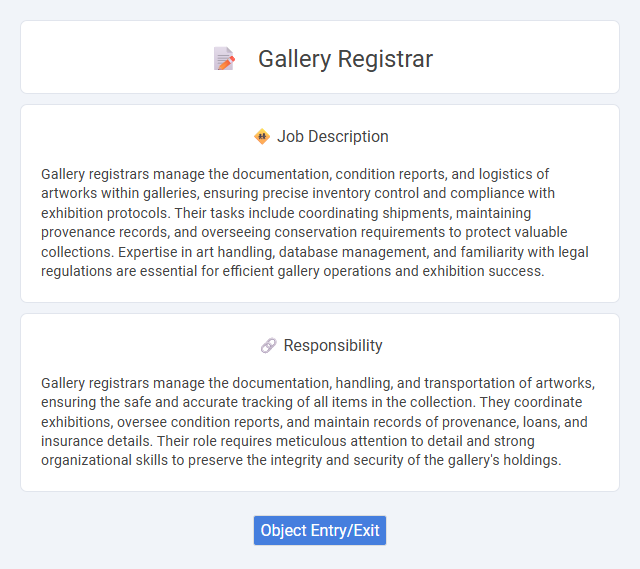
Gallery registrars manage the documentation, condition reports, and logistics of artworks within galleries, ensuring precise inventory control and compliance with exhibition protocols. Their tasks include coordinating shipments, maintaining provenance records, and overseeing conservation requirements to protect valuable collections. Expertise in art handling, database management, and familiarity with legal regulations are essential for efficient gallery operations and exhibition success.
People with strong organizational skills and attention to detail will likely be suitable for a Gallery Registrar job, as the role involves managing art inventory and coordinating logistics. Those who enjoy working in a structured environment and can maintain accurate records under pressure may fit well with the demands of this position. Candidates who prefer dynamic, creative tasks with less routine might find the administrative nature of the role less appealing.
Qualification
A gallery registrar should possess a bachelor's degree in art history, museum studies, or a related field, complemented by experience in art handling, cataloging, and collection management. Strong organizational and communication skills are essential for coordinating exhibitions, maintaining provenance records, and ensuring proper care of artworks. Proficiency in database software and knowledge of conservation techniques further enhance a registrar's ability to manage gallery inventories effectively.
Responsibility
Gallery registrars manage the documentation, handling, and transportation of artworks, ensuring the safe and accurate tracking of all items in the collection. They coordinate exhibitions, oversee condition reports, and maintain records of provenance, loans, and insurance details. Their role requires meticulous attention to detail and strong organizational skills to preserve the integrity and security of the gallery's holdings.
Benefit
Gallery registrar jobs likely offer benefits such as gaining extensive knowledge of art handling and exhibition logistics, which can enhance career prospects in the art world. There is a strong probability of developing valuable organizational and communication skills through managing collections and coordinating with artists and curators. Access to exclusive exhibitions and networking opportunities within the art community may also be significant advantages of this role.
Challenge
The role of a Gallery Registrar likely involves complex challenges such as managing intricate inventory systems and ensuring the safe handling and transportation of valuable artworks. There may be considerable pressure to coordinate exhibition schedules while maintaining stringent documentation and compliance standards. Navigating unexpected issues like damage claims or loan agreements could require swift problem-solving and meticulous attention to detail.
Career Advancement
A Gallery Registrar manages the documentation, condition, and movement of artworks, crucial for the smooth operation and preservation of collections. Expertise in art handling, inventory control, and exhibition coordination opens pathways to senior roles such as Collections Manager or Curatorial Director. Developing skills in database management and provenance research significantly enhances career advancement opportunities within museums, galleries, and auction houses.
Key Terms
Object Entry/Exit
Gallery registrars manage precise documentation and tracking of artworks, ensuring accurate object entry and exit records to maintain exhibition integrity. Strict protocols for condition reporting, labeling, and location updates minimize risk during transportation and handling. Expertise in inventory systems and compliance with loan agreements supports seamless coordination between artists, lenders, and galleries.
 kuljobs.com
kuljobs.com